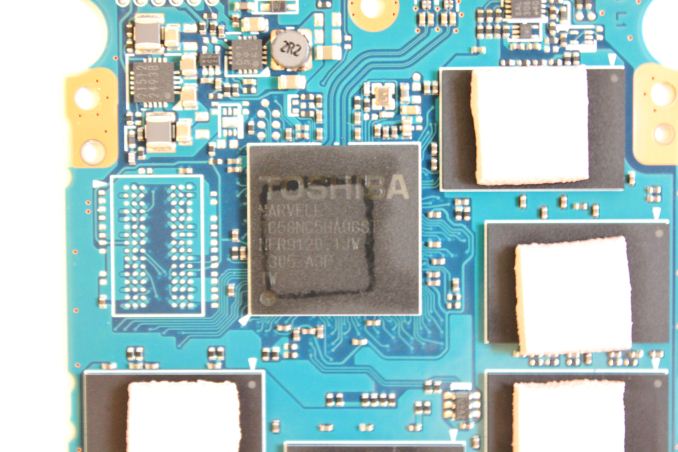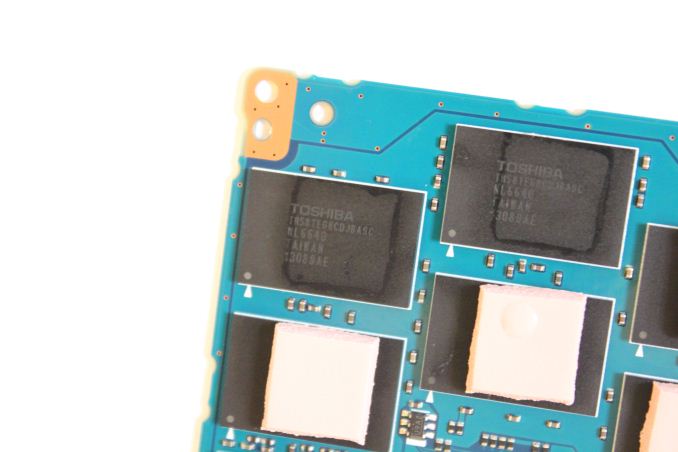Strontium Hawk (240GB) Review
by Kristian Vättö on June 25, 2013 8:00 AM ESTInside The Drive
All major chips are covered by pink thermal pads for heat dissipation. The interesting thing about the controller is that while it's based on Marvell silicon, it does not require any external DRAM. One of the reasons why SSD OEMs have preferred SandForce controllers is that they require no DRAM, which helps to drive costs down. The DRAM is mainly needed for caching the NAND mapping table, although some manufacturers also use it to cache writes, but it's certainly possible to build a design that doesn't require any external DRAM. Especially if you have access to the silicon (like I suspect Toshiba does; this doesn't seem like an off-the-shelf Marvell controller), you can make sure the controller has sufficient built-in caches to eliminate the need for DRAM. What's odd is that there is, however, an empty socket for DRAM next to the controller. It seems that either some models come with additional DRAM (bigger capacities may require a larger NAND mapping table) or the PCB design was simply finalized before the controller/firmware. I asked Strontium about the lack of DRAM but unfortunately they didn't have any knowledge of its purpose as it's purely a Toshiba/Marvell design.
As for the NAND, there are eight packages and each package is 32GiB (4x8GiB) in size.
Test System
| CPU | Intel Core i5-2500K running at 3.3GHz (Turbo and EIST enabled) |
| Motherboard | AsRock Z68 Pro3 |
| Chipset | Intel Z68 |
| Chipset Drivers | Intel 9.1.1.1015 + Intel RST 10.2 |
| Memory | G.Skill RipjawsX DDR3-1600 4 x 8GB (9-9-9-24) |
| Video Card |
XFX AMD Radeon HD 6850 XXX (800MHz core clock; 4.2GHz GDDR5 effective) |
| Video Drivers | AMD Catalyst 10.1 |
| Desktop Resolution | 1920 x 1080 |
| OS | Windows 7 x64 |
Thanks to G.Skill for the RipjawsX 32GB DDR3 DRAM kit













26 Comments
View All Comments
ssj3gohan - Wednesday, June 26, 2013 - link
Wait, what?! HIPM and DIPM have been standard features that are always enabled on every intel desktop system since the intel 5 series at least (and AM2+ on the AMD side, which had other reasons). The only reason not to have HIPM and DIPM is your choice of OS. It's a driver-enabled feature, it doesn't work without explicitly enabling it.Kristian Vättö - Wednesday, June 26, 2013 - link
That's not true. You can do the registry hack and get the option to enable HIPM+DIPM but that will have zero impact on power consumption on a desktop system. We've tried four different motherboards including Intel-branded ones and also both Windows 7 and 8 without success. That's why it took us so long to start doing HIPM+DIPM tests as Anand had to take an Ultrabook apart just for power testing and obviously I don't have access to that system due to geographical issues.JDG1980 - Tuesday, June 25, 2013 - link
If you want a Toshiba drive, why not just buy a Toshiba drive instead of one rebranded by a no-name company? I don't see the point of this.JarredWalton - Tuesday, June 25, 2013 - link
It's cheaper and uses the same hardware and firmware?Kristian Vättö - Tuesday, June 25, 2013 - link
Toshiba has quite poor retail presence, so Strontium may be targeting the markets where the availability of Toshiba SSDs is either very poor or non-existent.HisDivineOrder - Tuesday, June 25, 2013 - link
My concern would be what happens when they change products and firmwares are... nonexistent. SSD's are still far too temperamental to trust just some nobody who likes to throw caution to the wind.OCZ can't even be trusted in this regard.
Samsung, Intel, Micron/Crucial, maaaaybe Sandisk.
bji - Tuesday, June 25, 2013 - link
Can OCZ be trusted in *any* regard?zanon - Tuesday, June 25, 2013 - link
Kristian no they couldn't, seriously what the hell? We *still* have people arguing wrongly in freaking 2013? "Giga" is an SI prefix, it's base-10. That's what it is, anything else is wrong. This is particularly surprisingly from a technology enthusiast, as tech depends on precision, not random overloaded definitions. Maybe you'd like to suggest that they come up with their own definitions of "kilogram" and "pound" too with whatever mass they feel like? That sounds like a recipe for success!
If they want to show base-2, then they can use KiB/MiB/GiB/TiB/PiB. I don't think those sound the greatest but whatever, they're precise, correct, and the international standard (IEC 60027, published in *1999*). Storage makers were never wrong to use the SI prefixes and have base-10 numbers of sectors.
If anything the problem is Microsoft, who should long since have switched to displaying GB instead of GiB. Even Apple finally updated ages ago.
Kristian Vättö - Tuesday, June 25, 2013 - link
The problem is that Giga is not only an SI prefix, it's also a JEDEC prefix where Giga is defined as 1024^3. I do agree that Giga should only be used as an SI prefix (i.e. meaning 1000^3) but I guess someone at JEDEC thought that since 1000^3 and 1024^3 are "close enough", lets just call them the same.I also agree that it's Microsoft who should just change to the SI standard and define GB as 1000^3 bytes like Apple did. My point about Intel was that it's useless for a small OEM like Strontium to differ from the norm and I don't see Intel or anyone else switching away from the SI standard because the advertised capacities would end up being smaller than they are now.
KAlmquist - Wednesday, June 26, 2013 - link
"Storage makers were never wrong to use the SI prefixes"This is, I believe, inconsistent with your preceding paragraph. When disk drive manufacturers came up with their own definition of megabyte to make their disk drives seem larger, that created the same problems you envision if someone came up with their own definitions for "kilogram" and "pound".
As you note, that the IEC has decided to endorse the disk drive manufacture's definition of "megabyte" and has invented the term "mebibyte" to refer to a megabyte. That's a response to the linguistic mess created by the disk drive manufacturers; it doesn't justify creating the mess in the first place.
Meanwhile, as Kristian notes, JEDEC is sticking with the original meaning of the word. Words can acquire new meanings fairly quickly, but it takes a long time (on the order of 100 years) for a word to lose a well-established meaning.